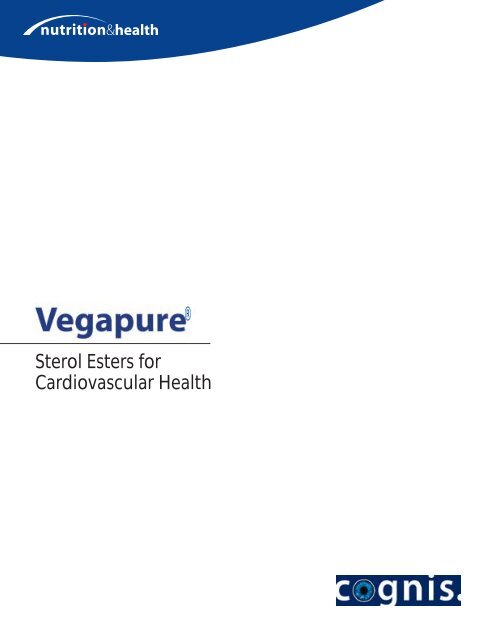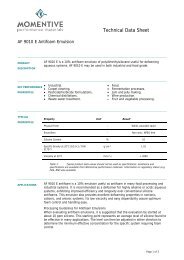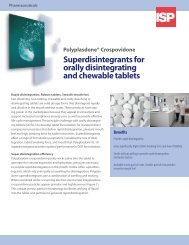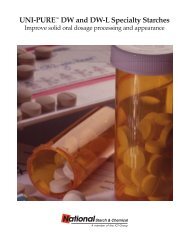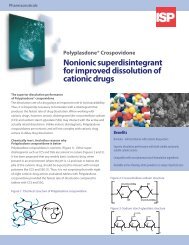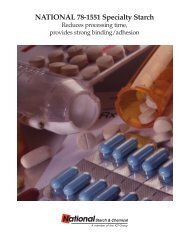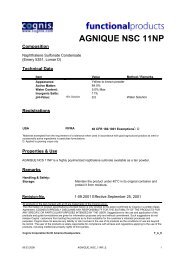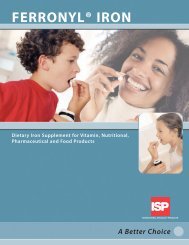Vegapure® Sterol Esters - Anshul Life Sciences
Vegapure® Sterol Esters - Anshul Life Sciences
Vegapure® Sterol Esters - Anshul Life Sciences
- No tags were found...
You also want an ePaper? Increase the reach of your titles
YUMPU automatically turns print PDFs into web optimized ePapers that Google loves.
®<strong>Sterol</strong> <strong>Esters</strong> forCardiovascular Health
<strong>Vegapure®</strong> <strong>Sterol</strong> <strong>Esters</strong> – Dietary Source,Dietary Gap<strong>Sterol</strong>s and sterol esters are found naturally in vegetables, fruit, legumes, nuts, and grains(Table 1). Health authorities continue to emphasize the importance of fruits and vegetablesin a healthy diet, yet few of us eat enough every day. Only 9 to 32 percent of Americans(depending on the cited study) eat the U.S. Government’s recommended five daily servings offruits and vegetables. In addition, because concentrated levels of sterols are associated withhigh-fat foods, health conscious consumers limiting fat intake may omit these foods fromtheir diets. As a consequence, many consumers may miss a significant source of sterols (Table2). This dietary gap creates a need for sterol ester supplementation.Table 1Food Source<strong>Sterol</strong> Content (mg) per 100 g of Food Source viRice bran oil 1,190Corn oil 968Sesame seeds 714Safflower oil 444Soybean oil 250Olive oil 221Peanuts 220Italian salad dressing 121Garbanzo beans 35Bananas 16Carrots 12Tomatoes 7Table 2Regional Population Dietary Plant <strong>Sterol</strong> Intake Minimum Recommended(mg / day)<strong>Sterol</strong> Intake (mg / day) viiScandinavia viii 398Japan ix 373Greece x 358Britain xi 158America xii, xiii, xiv 78-250 812 (equivalent to 1,300 mg<strong>Sterol</strong> <strong>Esters</strong>)<strong>Vegapure®</strong> <strong>Sterol</strong> <strong>Esters</strong> – Source and Definition<strong>Sterol</strong>s are a family of fat-like substances, including sitosterol, campesterol, stigmasterol, andother naturally occurring sterols (Figure 1). <strong>Vegapure®</strong> contains the same major sterols thatare the basis for the FDA health claim: sitosterol, campesterol and stigmasterol, in quantitiesthat exceed the minimum required content (Table 3).The sterols are esterified with food-grade sunflower oil fatty acids to sterol esters (Figure 2).Sunflower oil fatty acid is a rich source of linoleic acid, a polyunsaturated fatty acid.Esterification allows the sterols to be more soluble in oils, and provides an effective vehiclefor delivery of sterols to the small intestine. In fact, esterification of free sterols to sterol estersincreases their oil solubility ten-fold xv . Once inside the body, sterol ester is cleaved to sterol,thus sterol and sterol ester are used interchangeably in discussions. One gram of vegetablesterol is equivalent to about 1.6 grams of vegetable sterol ester.2
Human Cholesterol Digestion and AbsorptionCholesterol is an essential component of cell membranes and a precursor to bile acids andsome hormones. Most of the body’s cholesterol is made by the liver, with additional amountsprovided by diet (Table 6). The fast turnover rate of intestinal cells supplies another source ofcholesterol from old cells that have been “sloughed off”. Thus, the amount of cholesterolavailable for absorption comes from the contribution of bile (about 1,000 mg per day), diet(200 - 500 mg per day from typical American diet) and intestinal cells (250 - 400 mg per day).Table 6Typical U.S. Adult Typical Contribution Typical Contribution fromDietary Intake from Liver (Bile) Intestinal Cell Turnover(mg / day) (mg / day) (mg / day)Cholesterol 200-500 600-1,000 250-400Figure 4 depicts what happens in the intestine as part of the digestion and absorption offat-soluble nutrients. Consumption of fat-soluble dietary components, such as cholesteroland triglycerides (the main component in fat), trigger a release of bile from the gallbladder(produced in the liver) into the intestine. Bile salts are needed to form "micelles", or emulsifiedlipid droplets. Because our bodies are made up mostly of water, fat-soluble dietary compoundsmust be "packaged" with an emulsifier to be delivered where needed. In this case,the micelles are needed to absorb cholesterol and other fat-soluble nutrients.Once absorbed into the intestinal cells, new packages called chylomicrons are secreted whichcarry cholesterol, other fats and proteins to the liver. The liver further processes these nutrientsand produces the very low-density lipoprotein (VLDL) particles, which contain mostlyfat and cholesterol, and small amounts of protein. Eventually, the VLDL becomes low densitylipoprotein (LDL), otherwise known as "bad cholesterol," because these are the primarycholesterol carriers to the circulatory system and other tissues in the body.Human Cholesterol Digestion and Absorptionin the Presence of <strong>Vegapure®</strong> <strong>Sterol</strong> <strong>Esters</strong>Figure 5 shows how cholesterol absorption is affected by the addition of <strong>Vegapure®</strong>vegetable sterol esters to the diet. <strong>Sterol</strong> esters deliver sterols to the small intestine as theester is cleaved, or broken apart. <strong>Sterol</strong>s compete with and displace cholesterol from themicelles. Under some circumstances, sterols may have greater affinity for the micelles thancholesterol. In this way, sterols interfere with cholesterol incorporation into the micelles,thus preventing some cholesterol from being absorbed and incorporated into chylomicrons.The liver processes the chylomicrons as previously described. The body has a mechanism toincrease endogenous cholesterol (cholesterol produced by the liver) production if it sensesthat less cholesterol is being absorbed. This increase in endogenous cholesterol productionis less than the cholesterol-lowering effect of sterols, resulting in a net cholesterol reduction.There are dozens of studies showing the cholesterol lowering effect of sterols. Many ofthese studies using Cognis’ sterol esters were used in the U.S. FDA’s determination thatsterols lower cholesterol. The wide variety of study designs and subjects leads to a rangein typical cholesterol reduction. Cognis’ review of the studies indicates that a cholesterolreduction of 10% can be reasonably achieved by the addition of sterol esters to the diet,consumed in two servings per day.5
Figure 6<strong>Vegapure®</strong> <strong>Sterol</strong> <strong>Esters</strong> Structure –the Key to Cholesterol Reduction<strong>Sterol</strong>s have a chemical structure resembling that of cholesterol, differing at only one placein the structure, where an additional side chain is present on sterols. Sitosterol differs fromcholesterol in that an ethyl (2-carbon) group is present on the side chain (Figure 6).Campesterol and stigmasterol are also very similar in structure to cholesterol.Sitosterol and Cholesterol Structure ComparisonHOSitosterolHOCholesterolIn practical terms, this similar chemical structure translates to a natural competitor withcholesterol. <strong>Sterol</strong>s reduce the absorption of dietary cholesterol, as well as the reabsorptionof endogenous cholesterol from the digestive tract. Less cholesterol absorption leads to lowerblood levels of total and low-density lipoprotein (LDL) cholesterol, and thereby can reducethe risk of coronary heart disease.<strong>Vegapure®</strong> <strong>Sterol</strong> <strong>Esters</strong> AbsorptionAlthough the structures of sterols are similar to cholesterol, few sterols are actually absorbed.Approximately half of the cholesterol in our diet is absorbed. In contrast, much lower levelsof the sterols are absorbed, ranging from about 5-16% (Figure 5). As the intake of sterols isincreased, the percent absorbed actually decreases, leading to a reduced efficiency of absorption.In addition, sterols are eliminated faster than cholesterol through the bile, and combinedwith a lower absorption, contribute to blood levels of sterols that are about 100-fold less thancholesterol blood levels.Figure 7Cholesterol and <strong>Sterol</strong> Absorption Efficiency xviii50% Absorption16<strong>Sterol</strong>s5 5CholesterolCampesterolSitosterolSigmasterol7
Other Effects of <strong>Vegapure®</strong> <strong>Sterol</strong> <strong>Esters</strong><strong>Sterol</strong> esters lower LDL, or "bad" cholesterol levels. There is typically no effect on high densitylipoprotein (HDL), or "good" cholesterol levels. This results in a typical improvement in theLDL/HDL ratio. Consistently, there is no effect on triglyceride levels.<strong>Sterol</strong> esters are an excellent complimentary regime for people taking statins xix , whichreduce cholesterol by inhibiting cholesterol synthesis. <strong>Sterol</strong> esters and statins work towardscholesterol reduction via two different, but compatible mechanisms.Some studies report a reduction in serum carotenoid levels, but the reduced levels are withinthe normal range of blood carotenoids seen in the population. Furthermore, the reductionmay not be significant when calculated as a percent of cholesterol (or "lipid standardized").As reported by an American Heart Association spokesperson xx , the reduction is estimatedto be in the 5 to 10% range, which is within the level of tolerability. If formulators want toprovide full carotenoid availability, addition of Betatene® Natural Mixed Carotenoids isrecommended.<strong>Vegapure®</strong> <strong>Sterol</strong> <strong>Esters</strong> – A CompleteProduct Range<strong>Vegapure®</strong> is available in several forms to fit numerous formulation needs. Please refer to theProduct Data Sheets for complete technical information. <strong>Vegapure®</strong> 95 is our highest concentration sterol ester available. The sterol ester is a freeflowingoil at 35°C that makes it suitable for soft gelatin encapsulation. This high puritysterol ester allows for minimal dosage size. <strong>Vegapure®</strong> 67WDP is a high potency water dispersible powder. Excellent water dispersibilitymakes this product ideal for drink mix formulations. Also ideal for energy bars.All <strong>Vegapure®</strong> products are produced to Cognis’ exacting standards for quality includingcurrent Good Manufacturing Practices and ISO 9001 compliance. <strong>Vegapure®</strong> products meet allquality requirements detailed in 21 CFR 101.8
Cognis Nutrition and Health – Your NaturalBusiness PartnerOver 40 years ago, Cognis invested in facilities to purify sterols from vegetable oil to becomethe world leader in sterol processing. Cognis is the world’s largest supplier of sterol and sterolester, with two stand-alone production facilities for supply security. As always, Cognis is readyto support the success of your brands: Marketing strategies and co-promotional opportunities to stimulate consumer demand Technical assistance in formulating high-quality consumer products Scientific support to provide consolidated and complete Science Packets which providethe foundation for your products Public relations personnel to pull in the latest news on consumer and scientific trends, andreport on the trends Cognis is setting Customer service specialists who help with product samples, order placement andtracking, product documentation, and inventory planning.Together with Cognis, your products can make a positive impact on the world’s greatesthealth risk: cardiovascular disease.9
Notesi. Rodgers, A., Vaughan, P., Prentice, T., Edejer, T., Evans, D., Lowe, J., "World Health Report 2002, Reducing Risks,Promoting Healthy <strong>Life</strong>," World Health Organization, October 2002.ii.iii.iv.Sitosterol, Pollack, OJ and Kritchevsky, D. 1981. S. Karger AG, Basel, Switzerland.Food and Drug Administration, Department of Health and Human Services. Food Labeling: Health Claims:Plant <strong>Sterol</strong>/Stanol <strong>Esters</strong> and Coronary Heart Disease: Interim Final Rule. Federal Register Vol. 65, No. 175;September 8, 2000 Rules and Regulations.See note iii above.v. Foret, John B. Letter from John B. Foret, FDA, to David Koop, Pharmavite, August 26, 2002. www.fda.gov.vi. Moreau, RA, Norton, RA and Hicks, KB. Inform. 1999;10:572.vii. See note iii above.viii. Miettinen, T.A., and A. Tarpila, "Fecal Beta-sitosterol in Patients with Diverticular Diseae of the Colon and inVegetarians," Scandinavian Journal of Gastroenterology, vol. 13, pp. 573-576, 1978.ix.Hirai K., C. Shimazu, R. Takezoe, and Y. Ozek, "Cholesterol, Phytosterol and Polyunsaturated Fatty Acid Levelsin 1982 and 1957 Japanese Diets," Journal of Nutritional Science and Vitaminology, vol. 32, pp. 363-372, 1986.x. DeVries, J.H.M., A. Jansen, D. Kromhout, P. van de Bovenkamp, W.A. van Staveren, R.P. Mensink, and M.D.Katan, "The Fatty Acid and <strong>Sterol</strong> Content of Food Composites of Middle-Aged Men in Seven Countries,"Journal of Food Composition and Analysis, vol. 10, pp. 115-141, 1997.xi.Morton, G.M., S.M. Lee, D.H. Buss, and P. Lawrence, "Intakes and Major Dietary Sources of Cholesterol andPhytosterols in the British Diet," Journal of Human Nutrition and Dietetics, vol. 8, pp. 429-440, 1995.xii. Nair, P.P., N. Turjman, G. Kessie, B. Calkins, G.T. Goodman, H. Davidovitz, and G. Nimmagadda, "Diet, NutritionIntake, and Metabolism in Populations at High and Low Risk for Colon Cancer. Dietary Cholesterol, Beta-Sitosterol, and Stigmasterol," American Journal of Clinical Nutrition, vol. 440, pp. 927-930, 1984.xiii. DeVries, J.H.M., A. Jansen, D. Kromhout, P. van de Bovenkamp, W.A. van Staveren, R.P. Mensink, and M.D.Katan, "The Fatty Acid and <strong>Sterol</strong> Content of Food Composites of Middle-Aged Men in Seven Countries,"Journal of Food Composition and Analysis, vol. 10, pp. 115-141, 1997.xiv. Ling, W.H., and P.J.H. Jones, "Dietary Phytosterols: A Review of Metabolism, Benefits, and Side Effects," <strong>Life</strong><strong>Sciences</strong>, vol. 57, pp. 195-206, 1995.xv. Lipton, "Petition for Health Claim – Vegetable Oil <strong>Sterol</strong> <strong>Esters</strong> and Coronary Heart Disease," Item CP1,Docket 00P-1275, Dockets Management Branch, February 1, 2000, pp. 14 and 99.xvi. Food and Drug Administration, Department of Health and Human Services. Food Labeling: Health Claims:Plant <strong>Sterol</strong>/Stanol <strong>Esters</strong> and Coronary Heart Disease: Interim Final Rule. Federal Register Vol. 65, No. 175;September 8, 2000 Rules and Regulations, p. 54705.xvii. Taylor, Christine L. Letter from Christine L. Taylor, FDA, to Fred L. Shinnick, Cargill Health and FoodTechnologics. http://www.cfsan.fda.gov/~dms/ds-ltr30.html.xviii. Lutjohann, E., et al. J. Lipid Research. 1995;36:1763 and Heinemann, T., et al. Eur J Clin Invest. 1993;23:827 andGylling, H., et al., J. Lipid Research. 1999;40:593.xix. Simons, L. A. MD, "Additive Effect of Plant <strong>Sterol</strong>-Ester Margarine and Cerivastatin in Lowering Low-DensityLipoprotein Cholesterol in Primary Hypercholesterolemia," The American Journal of Cardiology, vol. 90,pp. 737-740, October 2002.xx. New Nutrition Business, News Analysis, "Unilever Pushes Ahead with European Cholesterol-Lowering BrandExtensions. But are <strong>Sterol</strong>s Stalled Elsewhere," Vol. 7, No. 11; pp. 3-5. ISSN 1464-3308. September 2002.10
For a complete listing of Cognis’products as well as a currentlisting of international offices andcontacts, please visit our web siteat www.cognis.com.www.cognis.com© 2004 Cognis CorporationPrinted in the U.S.A. 5M


